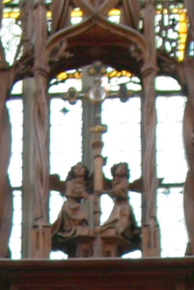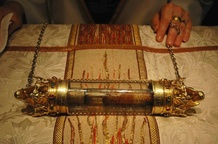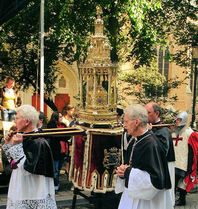Homage to the Relic
Brief Overview
The Holy Blood Altar was originally designed and constructed for the purpose of housing a relic of Precious Blood. Serving as a large reliquary for the crystal capsule located at the top of the Altarpiece, the Altar of Holy Blood emphasizes the importance of the presentation of the relic with its beautiful and unique construction. This relic served to be important not only to the purpose of the Altar and the church, but to the town of Rothenburg ob der Tauber, making it an important Pilgrimage site.
Relic Classification and Significance
A relic is an object that was once connected with the body of a saint. It was believed that a person’s virtue and holiness did not die with him, but that these elements continued to reside within his/her body. This was not exclusive to physical body parts of saints, but also to objects that had come in to contact with person of holy nature. There are four existing classes of relics. The first, and the most coveted, is the actual bodily remain of a saint or holy person. The Precious Blood would fall within this first class of relics, making the location of Saint Jacob's church very important and sacred. A second class relic was an article or object in which a saint frequently used, such as clothing or a book. The third and fourth-class reliquaries are not as revered, and are relics that have been essentially created by deliberately being touched to a first or second class relic, with the intent of creating a new relic. [i] A few relics were told to hold the holy powers of the saint from which it came. Miracles have been to be often associated with relics, and stories of incidences of blood re-liquefying and corpses impervious to decay. An example of this is the blood relic of St. Januarius, supposedly collected in to two vials at the time of his execution, the blood is now located in Naples, Italy. It is said that according to eyewitnesses dating back to the 14th century that the blood will periodically re-liquefy and redden. [ii] Relics did not always have to perform miracles to be regarded as valuable. The possession of a relic itself bestows prestige. Locations that housed important relics, such as those of the first and second-class were regarded as pilgrimage centers. These relics attract large numbers of pilgrims, and the cities that held these relics would economically prosper. Relics also carried a material value as well, churches and shrines would prosper from the large numbers of pilgrims coming through and making donations.[iii]
[i] Joe Nickell, Relics of Christ, Kentucky: The University Press, 2007
[ii] Joe Nickell, Looking for a Miracle, New York: Prometheus Books, 1993
[iii] Linda Kay Davidson, David Martin Gitlitz, Pilgrimage from the Ganges to Graceland, 2002.
Modern Day Use
A relic that is very similar to that the one located in the Altar of Holy Blood is the blood relic located
in Bruges, Belgium. It is a modern day example of the celebration and worship of a relic. It can help us understand what a relic is, and for what they were originally used. Most importantly, it can help us
understand why they were, and still are, so important.
The relic for which the Altar of Holy Blood was originally commissioned was a small drop of blood,
allegedly that of Jesus Christ, enclosed in a crystal capsule. The crystal capsule is displayed within a
cross that is located just above the central corpus of the altar, the sculpted scene of The Last Supper[i].
In Bruges, Belgium the Basilica of Holy Blood is a minor Basilica that houses a crystal phial that
within it contains a piece of cloth stained with the blood of Jesus.[ii]
The cloth was supposedly used by Joseph of Arimathea to clean Jesus’ body after it was taken off the
cross, in preparation for it to be entombed. It is said that the phial has not been opened for the last 837
years, but that is not for certain since the relic has been lost and found on several occasions
within that span of time. Though no miraculous powers have been claimed for this particular relic, nor the relic in Rothenburg ob der Tauber, it is still regarded as an object of deep reverence. Every year, on the day of Ascension (42 days after Easter) there is a procession held for the relic, and thousands of people and pilgrims flock to the streets of Bruges to watch the phial be paraded in its jeweled reliquary. The procession of the Holy Blood in its early stages started as just holding up the relic for the public to view from time to time, and has now evolved to a full blown parade. This example of relic worship serves to represent how relics were, and still are important in today's world. It also represents how revered first-class relics, such as the the Precious Blood, were and still are in the religious world.
[i] James Snyder, Northern Renaissance Art, New York: Abrams Inc, 1985
[ii] James Deely, “Pageantry and Passion” Connoisseur. 216: April, 124.
Page created by Jessica Calhoun, Northern Renaissance Art, May 2011



